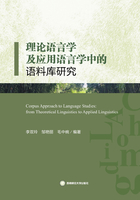
6. Implications and applications
So far we have discussed some major observations that can be drawn from our analyses; and we are now in a position to give answers to the questions raised at the beginning of this paper. To the first question, semantic sequence analysis can be an alternative way to capture disciplinary cultures, in particular the ways in which knowledge is constructed in different academic disciplines. The study shows that disciplinary cultures are represented or reflected by language use, supporting Becher's(1987:273)argument that the study of linguistic behaviour is useful“in illuminating our understanding of academic disciplines”. More notably, it has been exemplified that disciplinary culture can also, and may even more usefully, be characterized by semantic sequences, because semantic sequences capture both surface and underlying regularities of language use, as discussed above.
The second question relates to what insights can the analysis offer into the depiction and characterization of academic disciplines. In general, it has been shown that most of the sequences can be found in all four disciplines, although these sequences differ in terms of frequency across disciplines. This indicates that these disciplines share a lot in common and, at the same time, differ in degree from each other. The implication is that academic disciplines might better be characterized, not in terms of core defining characteristics, but rather, in terms of degree of resemblance. This is consistent with, for example, Groom's(2009:136)observation that “we may have begun to think about academic discourses in a rather different way:not as discrete and dis connected entities, but as complex networks of family resemblances”(cf. Trowler,2014). In a similar vein, McGrath (2016:87)notes that“a discipline will display various characteristics, but none of these characteristics are defining or necessary”, which further suggests that academic disciplines may be better depicted with respect to Wittgenstein's(1953)notion of “family resemblance”. This contributes substantially to a better understanding of disciplinary differences and transdisciplinary similarities, which helps to“improve the chances of mutual appreciation and respect, and hence to restore some sense of intellectual cohesion within the divided tribes of academe”(Becher,1981:121).
Work in this area would be of considerable significance for the teaching of academic writing in EAP/EFL contexts. We argue that such investigation can (at least):1)familiarize language learners with“what is often said”in specific disciplines, and 2)raise language learners'awareness of the patterned nature of language in use. These are discussed in turn.
As noted in Hyland(2008:20), “Numerous studies now show the extent to which language features are specific to particular disciplines, and that the best way to prepare students for their studies is not to search for universally appropriate teaching items, but to provide them with an understanding of the features of the discourses they will encounter in their particular courses”. Provided semantic sequences are a good way to characterize discourse features, as shown above, research using semantic sequences to investigate disciplinary epistemology would be of practical significance in that such investigation reveals how language is really used in specific disciplines, and as such, helps familiarize learners with both“what is often said” and “how it is said”by established scholars in their field.
The importance of phraseology or formulaic sequences in language teaching and learning has been increasingly recognized by applied linguists(e.g. Ellis,1997; Hunston & Francis,2000;Nattinger & DeCarrico,1992; Schmitt,2004; Wray,2000,2002,2008). The current investigation further demonstrates the important role phraseological patterns play in academic writing. What is particularly noteworthy is that the current investigation pushes the emphasis on lexical patterning towards an emphasis on semantic patterning, and therefore brings our conceptualization of text organization and development to a new level. That is, while traditionally researchers and teachers look at text organization and development in terms of patternings of lexico-grammatical forms, research on semantic sequences enables us to look at and understand text organization from an entirely new perspective and at a higher level of abstraction:what we see in text is not just strings of co-occurring tangible forms but also strings of abstract semantic features. In a similar vein, Bondi notes that,
More generally, the perspective offered by semantic sequences in describing discourses might be instrumental in a pedagogical representation of the meanings often expressed in a particular discourse and the range of resources available to student writers. Semantic sequences as such draw our attention to the fact that learning to read and write is learning to combine meanings and language resources in ways that allow learners to understand more efficiently the development of textual interaction and to use more effectively resources that characterize academic discourse.
(Bondi,2017:43)
The point, then, is that semantic sequences capture meaning(s)that are frequently expressed in disciplinary discourses and push our understanding of text development from an emphasis on lexical co-selection towards semantic co-selection. This further helps to raise language learners' awareness of the phraseological or patterned nature of language in use, which would“ultimately help to establish phraseology as a central component of language pedagogy”(Groom, 2005:273).
Additionally, the study has demonstrated how semantic sequences can be identified using grammar patterns as the starting point, which is itself of pedagogical value. Specifically, the methodology used is replicable; education practitioners and EFL learners themselves can, starting with other frequently occurring patterns (e.g. N that, it v-link ADJ to-inf)in academic discourse, practice semantic sequence analysis using the analytic procedure we outlined [cf. Römer's(2011)discussion of “teacher-corpus interaction” and “learner-corpus interaction”]. With this kind of hand-on experience, learners would be more aware of both the phraseological tendency of language in use and the disciplinary cultures of their field. It is in all these respects that it can be argued that semantic sequences are of pedagogical applications, in particular for the teaching and learning of academic writing in EAP/EFL contexts.